In computer science, data structures and algorithms are fundamental building blocks that determine the efficiency of software applications. A data structure defines how data is organized, stored, and retrieved, while an algorithm is a step-by-step process to solve a problem or perform a computation. Together, they form the backbone of every software program, and their synergy plays a critical role in optimizing performance.
The Role of Data Structures in Algorithms
Data structures directly influence the design and performance of algorithms. Choosing the right data structure can make an algorithm faster, more efficient, and easier to implement. For example, searching for an element in an unsorted list can take O(n) time using a simple array. However, using a binary search tree can reduce the time complexity to O(log n) for the same operation. Similarly, operations like inserting, deleting, or finding elements are significantly affected by the type of data structure used.
A hash table, for instance, allows for O(1) average-time complexity for insert and search operations, making it a preferred choice for scenarios requiring fast lookups. In contrast, linked lists may not offer the same efficiency for these operations but are useful when frequent insertions and deletions are required.
How Poor Data Structure Choices Impact Algorithm Efficiency
Using an inappropriate data structure can lead to inefficiencies that may hinder an algorithm’s performance. For instance, imagine using an array for implementing a queue. While it’s possible, it would require frequent shifts of elements to maintain order, resulting in a time complexity of O(n) for enqueue and dequeue operations. Instead, using a deque (double-ended queue) or a linked list can reduce this complexity to O(1).
Moreover, scalability becomes a concern with suboptimal choices. When processing large datasets, the wrong data structure can significantly increase memory usage and computational overhead, resulting in slower execution and poor resource utilization. Developers must carefully analyze the requirements of their application to avoid these pitfalls.
The Importance of Understanding the Trade-offs
No single data structure is universally superior; the choice depends on the problem at hand. Developers must weigh the trade-offs between time complexity, space complexity, and the specific requirements of the application. For example, while arrays are excellent for indexed access, they lack the flexibility of dynamic resizing offered by structures like linked lists. Similarly, trees provide efficient searching and sorting capabilities but can be more complex to implement than linear structures.
Data Structures and Algorithm Design: A Symbiotic Relationship
The relationship between data structures and algorithms is symbiotic. A well-designed algorithm depends on an appropriate data structure, and the efficiency of a data structure is maximized through the use of the right algorithm. Sorting algorithms like quicksort, mergesort, and heapsort, for example, perform better with specific data structures such as arrays or heaps.
Graphs, another powerful data structure, are commonly used in algorithms for shortest path calculations, such as Dijkstra’s algorithm or Floyd-Warshall. Trees, on the other hand, are essential in decision-making processes, such as those seen in Huffman encoding or binary search algorithms.
By understanding this interplay, software engineers can create robust, efficient solutions tailored to their specific needs. This knowledge not only enhances performance but also improves code maintainability and scalability. Ultimately, the synergy between data structures and algorithms is what empowers developers to write optimized and effective programs.
Practical Applications of Data Structures and Algorithms
Data structures and algorithms have practical applications in virtually every domain of technology. In web development, data structures like trees and graphs are used for rendering the Document Object Model (DOM) or optimizing network routes. In database systems, hash tables and B-trees are essential for indexing and query processing. Even machine learning relies heavily on algorithms for clustering, classification, and optimization, often requiring specialized data structures to handle large datasets efficiently.
For instance, social media platforms use graph-based algorithms to recommend friends or connections by analyzing relationships between users. Similarly, e-commerce platforms utilize data structures and algorithms for inventory management, personalized recommendations, and fraud detection. Mastery of these concepts is indispensable for developing innovative and scalable solutions.
Best Practices for Choosing the Right Data Structure
To select the optimal data structure for a specific algorithm, developers should consider the following:
Understand the Problem Requirements:
Analyze the nature of the problem, such as whether it requires fast lookups, dynamic resizing, or hierarchical representation.
Evaluate Time and Space Complexity:
Compare the computational cost of various operations for different data structures.
Test Scalability:
Ensure the chosen data structure can handle the expected size and complexity of the dataset.
Consider Simplicity:
While some data structures may offer theoretical advantages, simpler alternatives can often suffice for smaller or less demanding problems.
Leverage Libraries:
Many programming languages provide built-in implementations of common data structures, which are often optimized for performance.
Empower Your Career with Edvance
Mastering data structures and algorithms is a gateway to success in the tech industry, and Edvance is here to guide you. At Edvance, we offer a meticulously designed curriculum tailored to equip software engineers with the skills necessary to excel in data structures and algorithms (DSA) and system design. Our expert mentors bridge the gap between theoretical concepts and real-world applications, ensuring that every learner becomes job-ready for the most sought-after positions in the industry.
Beyond technical knowledge, Edvance provides comprehensive placement assistance, helping you land roles at top-tier companies. Whether you’re looking to refine your problem-solving skills or prepare for competitive coding interviews, Edvance is your partner in professional growth. By understanding the core concepts of data structures and algorithms and leveraging the expertise of platforms like Edvance, you can unlock new opportunities in the ever-evolving world of technology.
Why Data Structures and Algorithms Matter for Career Growth
Data structures and algorithms are more than just theoretical concepts; they are practical tools that employers highly value. Leading tech companies prioritize candidates who demonstrate proficiency in these areas during technical interviews. By mastering data structures like arrays, linked lists, stacks, queues, and advanced structures like hash tables and graphs, you not only enhance your problem-solving skills but also increase your chances of securing prestigious job offers.
At Edvance, we understand the importance of staying updated with industry trends. Our curriculum is continually refined to include the latest advancements in data structures and algorithms, ensuring that learners are equipped to tackle real-world challenges. Through interactive coding sessions, personalized feedback, and mock interviews, we help you build confidence and expertise in data structure and algorithm design.
Join Edvance and Elevate Your Skills
Whether you are a recent graduate or an experienced professional, Edvance offers tailored learning paths to suit your needs. Our programs are designed to provide a deep understanding of data structure and algorithm fundamentals, enabling you to solve complex problems with ease. From competitive programming to system design, we cover all aspects of software engineering, preparing you for a successful career in tech.
Join Edvance today and take the first step towards becoming a leader in the field of software engineering. With our support, you can achieve your career aspirations and make a lasting impact in the technology industry.




What Are the Different Types of Data structures? - Edvance
Data structures are fundamental to programming as they form the backbone of algorithms, enabling solutions to complex computational problems.